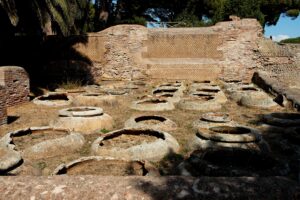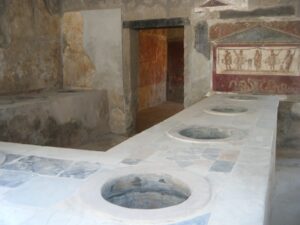Shopping in Ancient Rome and the Roman Empire
Table of Contents
The Origins and Impact of the Roman Shop
Introduction to Roman Shops
The concept of the shop, as understood in contemporary society, has its roots in ancient Rome. This evolution is primarily linked to the Roman tabernae, which functioned as early commercial spaces. These establishments were not merely venues for purchasing goods; they signified a transformative change in the conduct of commerce. The tabernae facilitated a diverse array of trades and services, marking a departure from earlier commercial practices that relied heavily on personal relationships and direct interactions between buyers and sellers.
Literature from around the time of Christ provides valuable insights into the existence and function of tabernae. Writers such as Livy and Dionysius of Halicarnassus mention shops. However, some claims regarding the early existence of shops are historically inaccurate, as they predate the introduction of currency.
Tabernae began to appear approximately two thousand two hundred years ago in urban centers. These shops catered to a wide spectrum of tradespeople, including bakers, blacksmiths, and textile merchants. Researchers have identified around five hundred distinct occupations in ancient Rome, underscoring the complexity and diversity of Roman economic life.
Development of Currency and Commerce
The emergence of tabernae coincided with the introduction of coin-based currency during the fourth and third centuries BC. This innovation facilitated trade and commerce, enabling transactions to occur without the necessity of personal connections. As urban areas expanded, the demand for more formalized commercial spaces became evident, leading to the establishment of permanent shops. The use of coins allowed for a more standardized method of exchange, which was crucial for the growth of commerce in increasingly populous cities.
Craftsmen and Home-Based Work
Prior to the rise of tabernae, many craftsmen operated from their homes, allowing for direct interaction with customers. This arrangement fostered personal relationships between producers and consumers. However, as urban centers grew larger, this model became less practical. The impersonal nature of larger cities created a demand for shops where transactions could occur independently of personal ties, paving the way for the establishment of tabernae. This shift marked a significant change in the dynamics of commerce, as it allowed for greater anonymity and efficiency in transactions.
Influence of Greek Commerce
Interestingly, the tradition of shops was largely absent in ancient Greece. In Greece, goods were typically sold in open markets or by itinerant street vendors. It was only later that shops began to emerge in Greek cities, highlighting a distinct difference in commercial practices between the two cultures. The Romans adopted and adapted various elements of Greek commerce, but the tabernae represented a unique development that was not present in the earlier Greek economic system.
Expansion and Role of Shops in Roman Cities
Expansion of the Roman Empire
The expansion of the Roman Empire during the second century BC played a crucial role in the proliferation of tabernae. As the empire conquered new territories, the demand for goods and services surged. In Pompeii, for instance, tabernae were strategically constructed around public buildings, indicating their incorporation in urban planning and daily life. This expansion not only increased the number of shops but also diversified the types of goods available, reflecting the varied needs of a growing population and economy.
Ostia: A Factual Example of Daily Commerce
Ostia, the ancient port city of Rome, offers an excellent example of how daily shopping and trade operated in the Roman Empire. Ostia was a crosspoint where citizens and traders met to fulfill their everyday needs. The city’s layout included numerous tabernae lining the main streets and the forum, each specializing in different goods such as food, pottery, textiles, and household items.
Residents typically bought staples like bread, olive oil, wine, and fish from local tabernae, which were stocked by traders who sourced goods from both the city’s hinterlands and the wider empire. Traders in Ostia often arrived by ship, unloading commodities directly at the harbor. These goods then passed through a network of wholesalers before reaching the retail tabernae.
Many tabernae in Ostia were simple shops with counters opening onto the street, allowing for direct interaction between seller and buyer. Some included small storage areas or even living quarters for the shopkeeper. The presence of scales and coin weights in archaeological remains shows how standardized trade practices ensured fair commerce. The density and variety of shops in Ostia underline the importance of tabernae as centers of daily life and economic activity.
Economic Structure and Social Division
Researchers indicate that the economic structure of ancient Rome contributed to social divisions. Wealthier citizens often operated textile workshops, while food vendors typically came from lower socioeconomic backgrounds. The disparity in access to resources and opportunities created a distinct separation between different classes, with the elite benefiting disproportionately from the economic activities centered around tabernae.
While wealth flowed into the empire, it concentrated in the hands of a small aristocratic class. The broader population did not experience the same economic advantages. The economic activities surrounding tabernae often reinforced existing social hierarchies, as access to resources and opportunities remained limited for lower classes.
Food Production and Consumption
The question of whether Romans prepared their own food at home remains a topic of debate among historians. Many food-related items have been lost over time, complicating our understanding of domestic life in ancient Rome. The role of tabernae in food distribution is particularly significant, as they likely served as primary sources for many citizens’ daily sustenance. The extent to which individuals relied on these shops for food versus preparing meals at home is still not fully understood.
Shops During Times of Conflict
During periods of war, tabernae around the Forum Romanum would often close, creating a noticeable absence in the city. This phenomenon was documented by writers who noted the eerie silence that accompanied the shuttering of shops. Such observations underscore the integral role of tabernae in the daily rhythm of Roman life, as their closure during conflicts disrupted the usual flow of commerce and social interaction.
Geographical Spread of Tabernae
While the concept of the shop was prevalent in larger urban centers, it did not spread uniformly across the empire. Smaller towns featured shops that were often attached to residences, indicating that the large-scale shopping complexes seen in major cities were not replicated everywhere. This geographical variation reflects the differing economic conditions and urban development patterns across the empire.

